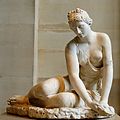Physical fitness
Physical fitness is the ability to be physically active, to move and respond to the environment. People can take various tests to measure their physical performance. Such tests are necessary for some occupations, such as soldiers and firefighters.
Physical fitness has two components: general fitness (a state of health and well-being) and specific fitness (the ability to perform specific aspects of sports or occupations).
Components of physical fitness
The President's Council on Physical Fitness and Sports — a study group sponsored by the United States Government — declines to offer a simple definition of physical fitness. Instead, it developed the following chart:[1]
| Physiological | Health-related | Skill related | Sports |
|---|---|---|---|
| Metabolic | Body composition | Agility | Team sport |
| Morphological | Cardiovascular fitness | Balance | Individual |
| Bone integrity | Flexibility | Coordination | Lifetime |
| Other | Endurance | Power | Other |
| Muscle strength | Speed | ||
| Reaction time | |||
| Other |
Health-related components: those factors that are related to how well the systems of your bodywork.
Body composition is the relative percentage of body fat compared to lean body mass (muscle, bone, water, etc)
Cardiovascular fitness: the ability of the circulatory system (heart and blood vessels) to supply oxygen to working muscles during exercise.
Flexibility: the range of movement possible at various joints.
Accordingly, a general-purpose physical fitness program must address those issues.[2]
Ancient icons of physical fitness
Heracles, the greatest hero of Greek mythology, and his child Telephos, Louvre.
Discus throwing, one of the original Ancient Greek Olympic sports. The statue is a Roman copy of a Greek original.
Hermes, an Olympian god and the patron of athletics and sports.
Related pages
References
| Wikimedia Commons has media related to Lua error in Module:Commons_link at line 62: attempt to index field 'wikibase' (a nil value).. |



